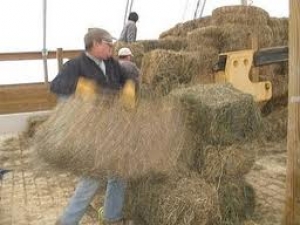Forage and Silage
Storage Methods To Retain Hay Nutrients

How hay is stacked in the field or hay yard impacts the amount of hay retained in each bale and the quality of hay remaining in the bale.
“Stacking hay in pyramid shaped piles can create conditions that cause damage,” says Barry Yaremcio, beef and forage specialist with Alberta Agriculture and Rural Development.
“If the stacked bales are left uncovered, rain or moisture that lands on the top bale of the pyramid runs down between the bales into the middle layer. The same thing happens when moisture from the middle layer moves down to the bottom layer. This stacking system can create the most damage compared to other stacking methods. Dry matter loss from this system can be as high as 20 per cent.
“The stacking of hay in a mushroom shape – the first bale flat side down on the ground and the second placed round side onto the upper flat surface of the bale creates less damage than the pyramid. The Prairie Agriculture Machinery Institute reported 10.6 per cent spoilage from the mushroom stacked bales.
"If storing bales outdoors over winter, place rows of single bales round side down with six inches of space between each bale in the row and space the rows three to four feet apart. Place the rows parallel to the prevailing winds to allow the snow to be blown out from between the rows."
“Damage to forage occurs where the bales touch each other,” adds Mr Yaremcio. “Storing hay on a high area or knoll allows rain or spring melt to run off rather than pool and damage the bottom of the bales.”
When hay is exposed to the elements for a year, damage occurs. Digestibility of the outer five inches of the bale is reduced by 20 per cent and overall forage digestibility in a round bale is reduced by 10 per cent.
If the hay is kept over for a second year, further weight loss occurs and digestibility is reduced even further. In some situations, this older hay could be no better than feeding cereal straw.





















